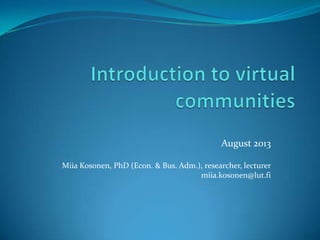Virtual communities
- 1. August 2013 Miia Kosonen, PhD (Econ. & Bus. Adm.), researcher, lecturer miia.kosonen@lut.fi
- 2. Virtual community concepts Technology-mediated community Virtual arena Online community Electronic community Virtual society Network community Electronic network Virtual network e-tribe Virtual public Online crowd Internet community Virtual community Virtual organizations F2F or physical communities Platforms: web 2.0, social media, online networking tools
- 3. Defining a virtual community People Shared interest Interactions - creating and maintaining community- level social capital; norms, trust, shared language Conversational technologies Preece, 2000; Ridings et al., 2002; Porter, 2004; Kosonen, 2008
- 4. Belonging to a virtual community Expectations Activities Sense of community - Feelings of membership - Identification with the group - Feelings of efficacy - Immersion - Getting info or emotional support - Building relationships Does the community fulfill my needs? If so, how? Uses & Gratifications: types of expected benefits What does the community do? How do members interact? What is my role in these activities? Katz et al., 1974; Nambisan & Baron, 2007, Blanchard, 2007, 2008; Tonteri et al., 2011
- 5. Perspectives into virtual communities Virtual community Economics Management Sociology Information systems Cognitive psychology Social psychology Communication - Rational choice theories - Collective action - Participation strategies - Individual learning processes - Motivation: intrinsic, extrinsic - Member personality - Behavioral intentions - Community design - Usability - Attachment, commitment - Identity, identification - We-intentions, group processes - Sense of virtual community, SOVC - TPB, MGB - Social capital, trust, norms - Digital sub-cultures - Effect on societies - Communication richness - Media types, online channels - De-individuation - Hyperpersonal communication - Macro: organizational design, new business models - Meso: innovation management, relationship marketing - Micro: community management
- 6. What is your perspective? …no matter from which discipline or business you represent, try to avoid these three common pitfalls: Overstating the newness of online social life – for decades, there have been virtual communities and community enthusiasts. Why not learn from their experiences? Focusing on online technology and forgetting people – communities are about people. Trying to include everything into one investigation – communities remain complex systems.

